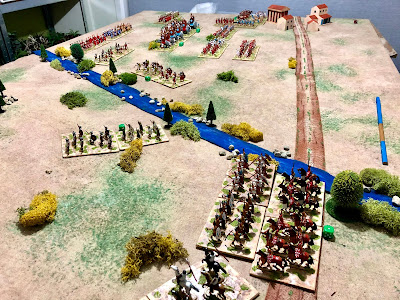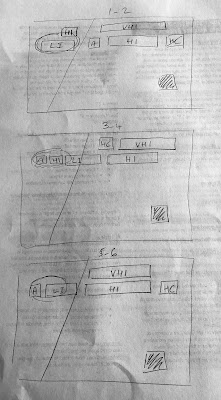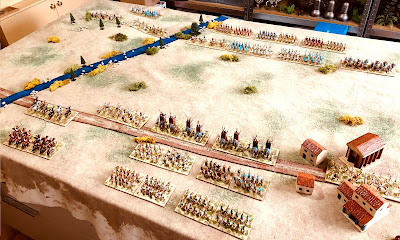I have been busily painting up the last few 2nd Punic War units I need, or think I need, while at the same time finally playing a few games. I always seem to start new periods with One-Hours Wargames (OHW) rules by Neil Thomas. As they are a quick way to get some models on the tabletop with minimal effort to learn the rules.
 |
| A game setup using a 6 x 4 foot table |
The games resulted in a few additions to the original OHW rules. These include:
- Units types geared towards from the 2nd Punic War (including elephants and catapults).
- Increase in unit base widths to make manoeuvring difficult (and the units look more substantial).
- A reduction in the number of hits before unit elimination which is partly offset with additional rally chance cards.
- An elephant berserk rule upon their elimination.
- Use of chance cards with some possible options to reflect both army characteristics and leadership quality.
As a solo gamer I often use chance cards in my games, but they are typically added on to the rules rather than incorporated with the rules themselves. The changes are my first attempt at trying to mesh the rules and chance cards together, and I have started with the Rally cards to offset the reduction of hits a unit takes before elimination (down from 15 to 13).
Here are my first variation of the OHW Ancient rules with the modifications mentioned above...
Units Types
The game is geared towards the 2nd Punic Wars and uses the following units types:
- Veteran Heavy Infantry
- Heavy Infantry
- Warband (Gallic Infantry)
- Light Infantry
- Light Cavalry
- Heavy Cavalry
- Elephants
- Catapults
The units need to be consistently based and I have been trying large base widths of 8”. This width creates naturally limits to the ability of units in formation to move around easily except when positioned on the flanks.
I have been playing games with 8-12 units per side using the army lists in Ancient and Medieval Wargaming by Neil Thomas as a guide to an army's make up.
 |
| My normal basing is 4x3 inches, but for these ancient games each unit has two bases to make units 8x3 inches. |
Sequence of play
Each player takes a turn to move, shoot and melee with their units in the following sequence:
- Draw chance card
- Movement
- Shooting
- Melee
- Eliminating units (and berserk elephants)
The game ends after 15 turns.
Movement
During the movement phase a player can move their units. A unit may move up to the distances listed below:
- Heavy Infantry - 6”
- Light Infantry, Warband, and Elephants - 9”
- Light and Heavy Cavalry - 12”
- Catapults - cannot move but are allowed to pivot.
Units turn by pivoting on their central point, and may do so at the start and end of their move.
Only light infantry may pass through other friendly units.
Units that move may not shoot.
Terrain
Terrain has an impact on a unit’s movement and combat.
- Woods - Only light infantry and warbands can enter
- Towns - No effect on movement and treat as broken ground for combat
- Marshland and lakes - Impassable to units
- Rivers - Can only be crossed at bridges and fords
- Broken Terran (e.g. Rocky, Fields and Streams) - Only infantry can enter and heavy infantry do not halve combat hits.
- Roads - Units moving all their move on roads add 3” to their move distance
Charges (Moving into contact)
Units may move into contact with enemy units, but have the following constraints:
- A unit may only turn up to 45 degrees at the start of their move
- Only one attacking unit can contact each side of an enemy unit (front, left flank, right flank, and rear)
Combat is resolved in the combat phase
Shooting
Only light infantry, light cavalry, and catapults can shoot. The procedure for shooting is as follows:
- Units may only shoot at a target within 45 degrees of their frontal facing.
- Light infantry and Light Cavalry only have a range of 12”, and catapults have a range of 24”.
- Assess the number of hits by rolling a D6-2. Halve hits for units in cover, heavy infantry, or elephants.
 |
| All models are HAT plastic 1/72 figures |
Combat
The procedure for combat is as follows:
Units only inflict hits during their own player turn.
Assess the number of hits
- Veteran Heavy Infantry - D6+2
- Heavy Infantry - D6
- Warband (Gauls) - D6 (D6+2 when first charging into combat)
- Light Infantry - D6-2
- Heavy Cavalry - D6
- Light Cavalry - D6-2
- Catapults - cannot attack in combat situations
- Elephants - D6 (regardless of unit type)
Halve hits for attacks on warbands, veteran heavy infantry, heavy infantry, and elephants. Ignore this rule if the attacking unit is an elephant.
If attacking from a flank or rear, all hits are doubled.
Units defending woods, towns, river crossings, or hills halve the number of hits.
Heavy infantry (including veterans) in broken terrain cannot halve hits.
Units cannot retire from combat which only ends with the elimination of one of the contesting sides. Units are allowed to face an attack upon their flank or rear, only if they are not already being engaged frontally.
Eliminating Units and Berserk Elephants
Units are eliminated after taking more than 12 hits. This is different to the 15 used in One-Hour Wargames, and the lower value is compensated by Rally chance cards which remove 2 hits from units (see chance cards).
When an elephant unit is eliminated, check to see if it goes berserk. Roll a D6 and:
- On a score of 1 or 2 the elephant charges the nearest friendly unit with 12” and inflicts D6 hits. After this the elephant unit is removed from play.
- On a score of 3 or the elephant charges the nearest enemy unit with 12” and inflicts D6 hits. After this the elephant unit is removed from play.
- On a score of 5 or 6 nothing happens and the elephant unit is removed from play as any other unit.
 |
| The elimination after 13 or more hits allows hits to be tracked with 2 dice. |
Chance Cards
As a solo wargamer I enjoy incorporating chance cards into a game to create uncertainty and also to reflect any army characteristics. In all there are 15 cards one for each turn (the cards also help you keep track of the turn).
The chance cards are acted upon during the turn they are drawn and cannot be carried over to another turn. The cards:
5 x No Event. Nothing happens
2 x Confusion. A player’s units cannot move this turn, but are allowed to pivot.
2 x Ammunition Shortage. A player’s units cannot shoot this turn.
2 x Initiative. One unit can make a move, shoot, or conduct a round of combat. The unit can still be activated as normal later.
3 x Rally. A player can units can remove 2 hits from all units.
1 x Demoralisation. Only half a player’s units in combat (rounding down) can attack.
To help create some army characteristics, the Roman army replaces one Initiative card with a rally card. This represents the ability of Roman armies to maintain discipline and keep on fighting. As for the Carthaginians they replace a Rally card with an Initiative card.
The same approach can be used for good and poor commanders. For poor commanders replace an Initiative card with a No Event card, and for good commanders replace a No Event card with an Initiative card.
There is opportunity for this to be taken further with supply. Armies with supply problems would replace a No Event card with an Ammunition Shortage card.



















































